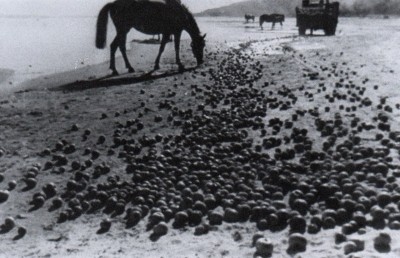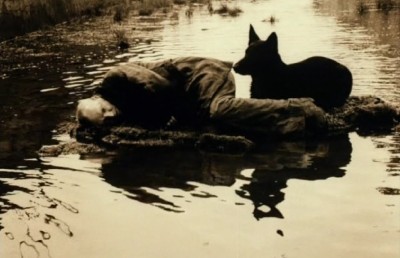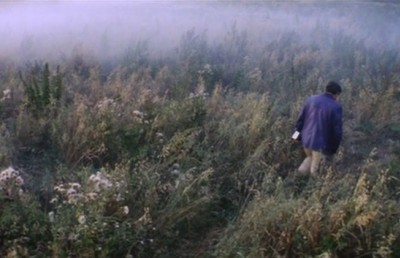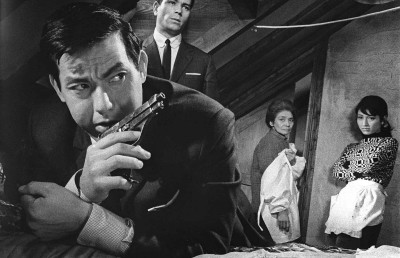The Hidden Blade
Change in Japanese Society
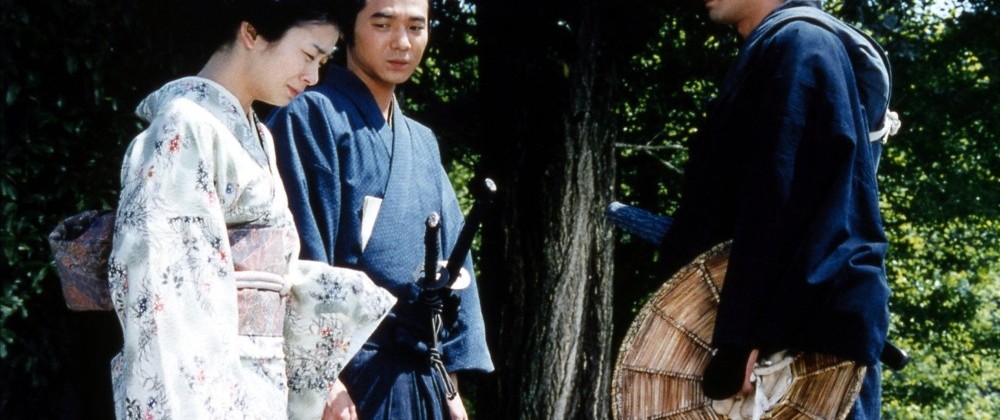
Introduction
Hidden Blade (dir. Yôji Yamada, 2004) portrays the beginning of the end; the end of the Tokugawa era (1600-1868) and the shift of political power from shogunate clans to the Imperial court of Japan. The concept of ‘change’ is the most significant theme of the film. The story takes place in the last years of the Tokugawa period when in Alain Silver’s words (2005, 258), “[an] ordinary samurai [is] caught up in the turbulent wake of the bakumatsu .” [1] The film’s story narrates how the political and social changes affect the lives of the people. The ‘ordinary samurai’, Munezô Katagiri (Masatoshi Nagase), as the film’s protagonist, should respond adequately to these changes.
The balance of this essay will be presented in three sections; the first part explains how Yamada, in the first ninety minutes of the film, carefully and gradually shows some of the changing elements of Japanese society. The next part focuses on the last forty minutes of the film, illustrating how the change happens in a visual sense and how it affects the protagonist’s samurai values. The third part is the conclusion of the essay, which draws out the director’s message, i.e. how the Japanese should deal with the changes in their lives.
The changing elements
Yôji Yamada did not arbitrarily choose a samurai as the hero; there are several reasons for putting a warrior in the middle of the changes. Traditionally, Jidaigeki or period films are focused on the lives and deeds of the samurai class. The bravery and charisma of the members of this class are tools for calling the attention of spectators. As Akira Kurosawa (1983) argues in his autobiography, films’ audiences try to escape from their own weaknesses by succumbing to the great heroes of narrative films. Therefore, viewers feel the effects of changes to a samurai’s life more profoundly when they have awe for his character. Moreover, by choosing a samurai, Yamada refers to the depth of potential changes in Japanese society. Sybil Thornton (2008, 176) explains this point as follows: “the restoration will be the death of a class, the samurai, and the substitution of the sword by modern technology.” Thus, the warrior class, which was eliminated by the new political system, provides the director with a great opportunity to illustrate the full extent of the ‘change’.
Munezô, the protagonist, stands as a contemporary Japanese man who tries to understand the new world. Thornton (2008, 200) says, “The Japanese have had a rough time in the last fifteen years […] the economic bubble of 1986-1990 burst and left Japan in recession for ten years.” So, a viewer who is distressed by all the social and economic unease could sympathise with the film’s hero; they are both in search of a solution for their problems.
As noted, the first ninety minutes of the film are about elements of Jamoese society which face change. The two major ones are male-female relations and the ideals of the samurai class. Thornton (2008, 197-198) sees the former element of the film as: “Hidden Blade begins with a departure scene and a comment that Edo [Tokyo] is so faraway and life will be hard without a wife; just before the end of the film there is a departure with the comments that Ezo (Hokkaido) is so faraway and if only Munezô had a wife to go with him.” Yaichirô Hazama (Yukiyoshi Ozawa) is the first traveller of the film. He goes to Edo without taking his wife; he has no qualms with this situation. He says to his friends that, “money can buy you many girls in Edo.” He expresses his opinion loud enough to be heard by his wife. She does not protest to this remark, for she is dominated by the hierarchy of Japanese society that asks for absolute devotion to the husband. Joan Mellen (1976, 3) sheds light on the matter by saying: “there is […] a pervasive sense in Japan that the identity of the nation and the feelings human beings have […] can be truly expressed only through a hierarchy of relationships.”
Yamada shows the antithetical relation of man and woman of the time with a panning camera movement that establishes the gap via Hazama, his friends from the clan and Hazama’s wife. Hazama is closer to his friends than to his wife. The wide-angle lens exaggerates the distance between husband and wife. Yamada, by choosing this lens, suggests that not only is it a male-oriented society, but also that Hazama does not love his wife (he does not even look at her). Furthermore, the pan movement is fast enough to suggest visually that this film is about changes that happen quickly. Chi Nakane’s words in Mellen (1976, 27) elaborate on the former point: “The sexual and emotional energy of the Japanese man is epitomised in the choice of feudal brotherhood over heterosexual love.” The director emphasises this point by presenting no dialogue between husband and wife; instead, Hazama is engaged vigorously in conversation with his samurai friends.
In contrast to Hazama, his wife (Reiko Takashima) has great loyalty and love for him, but she does not mention it. In the entirety of the film, the Tokugawa men and women do not talk about love. Towards the end of the film, when Hazama is now a criminal and fugitive and none of his male friends try to help him , [2] his wife is the only person who tries to save his life. It can thus be said that love is expressed through actions, not words. At first she goes to Munezô and reminds him of the old friendship between him and her husband. Unsuccessful in this venture, she offers herself to him as the payment for not killing her husband. Munezô is too noble and honest to take advantage of her. Also, he does not have any say in this case. He has been ordered to kill the rebellious Hazama by the clan. He must and he will respect the codes of bushido. He does not disobey his superiors and thus fights at the end with his friend. Munezô’s refusal does not stop the devoted wife. She instantly goes to the house of Chief Retainer Hori (Ken Ogata) and prostitutes herself to save her husband from death, but to no avail.
Munezô attempts to stand against the established relation between men and women in his society; as a romantic person, he initially portrays his love like everyone else by taking action rather expressing it by words. Not until he learns that Kie (Takako Matsu), his former maid, has been treated brutally by her husband and his family, does he break into Kie’s husband’s house. He then takes her away, and orders Kie’s husband to write a divorce statement. This act of love is seen as indecent by the rest of the community, and it tarnishes the hero’s reputation within the clan. The other issue is that after Kie’s divorce, there can be no marriage for her and Munezô. Kie explains this to her sister later; she and Munezô are from different castes (one is a farmer, another is a samurai). When her younger sister asks her what it means to be from different castes, Kie replies that she does not really know. So, although she is ignorant of the principle of codes, she follows them. By putting this scene in the film, Yamada tells the audience that when people follow certain traditions, they do so not because they approve of them but simply because it is a national condition. That is why, throughout the entire film, the viewers see the practice of codes by the characters; they are never told what the reason for having these traditions is.
Munezô wins his struggle against the society’s norms only at the very end; the film concludes whilst strongly suggesting a potential marriage between Munezô and Kie, when the hero has left his clan and resigned from his samurai status. Thornton (2008, 201) sees the result of this act thusly: “The hero of the Hidden Blade is saved by giving up his status […] he is able to marry the girl he loves.” This is the moment in the film that the hero verbally admits his love for Kie. Although not all the old habits are changing (he marries her not as a samurai), some of them begin to change (verbal expression of love).
In addition to the above idea, the film is also concerned with the idea of the ‘Westernisation’ of Japan which challenges the samurai principles. The story happens in a province far away from Edo, where the centre of change is occurring. Change starts to happen when an army instructor (sent from Edo) begins to teach the clan retainers how to use Western weaponry.
Paul Akamatsu (1972, 85) argues that China’s defeat in the First Opium War (1839-1842) made the Tokugawa government realise their vulnerability; “The advantage of western artillery was recognised in 1841.” This act of modernisation later on in the Meiji period expanded to other sections of the society, such as education, industry and so on. Notwithstanding, as it is common, every change leaves its marks. These marks are obvious in Japanese society. As Mellen (1976, 4) writes, “There is a hunger in Japan among many reflective people for radical and structural change, but the terms of that transformation continue to derive from a formal past, a period when national identity and sense of place were attached to rigid and hierarchical institutions.”
The dichotomy is the epiphenomenon of the above view. On one hand, people know that in order for the country and society to survive and prosper, change is essential. On the other hand, generation after generation have lived based upon impervious codes and ethics. It does not matter if these rules are right or wrong, fair or malicious. The point is that they stand as the order of society. Therefore, living and working under the flag of this binary system results in the confusion and dilemma of the society’s subjects. This is why only thirteen minutes into the film, Munezô manifests his feelings of guilt about not understanding the principals of the new Western artillery. As a clan’s samurai, he is a man of principles. He needs them to be able to function as a Japanese warrior. Furthermore, he is not the only retainer who has problems with the new fighting style. An older samurai tells the instructor that the more he sits in the class, listening to the lessons, the more stupid he feels. Besides the iconic element of this epigram, it can be argued that it suggests the lack of communication via the Western and Japanese principles. [3]
Conflict is the consequence of the above ‘lack’. This hypothesis is tested in the scene following the Buddhist wake sermon, which is held for Munezô’s late mother. Munezô’s uncle and his friend (another elderly samurai) criticise the protagonist on two grounds; firstly, he is learning how to use and handle Western weaponry. Secondly, he is criticised over his current marital status (Munezô is a bachelor). I believe this is the key scene of the first ninety minutes. The two old men reflect the past in its full scale. They have no doubt whatsoever in their ideals and codes. They practise the rules of bushido like absolute rules of a religion. They say that there is no honour in using Western rifles; one simply kills one’s enemy. The challenge and dignity of the one-on-one battle is gone; Noel Perrin in Prince (1991, 216-217) explains this point by writing, “The guns […] will come to alter the social codes of samurai warrior by making obsolete the skills of a brave sword man.” They also push Munezô into a corner for being single. When he protests that there is no relation between learning Western fighting skills and being single, they tell him that everything is related, so the lack of wife results in the desire to learn Western artillery. Yamada answers this criticism in a subtle way; it is not Munezô who answers the uncle’s question, but Samon Shimada (Hidetaka Yoshioka), Munezô’s brother-in-law. As a married man, he has a stronger voice against the uncle who stands as the defender of tradition. Samon says: “One of these days we need to change our views on everything.” The only person who practises this theory is Munezô, the protagonist who rids himself of his class and marries the woman he loves.
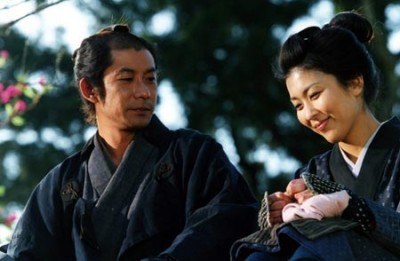
Masatoshi Nagase and Takako Matsu
The ‘change’
The final forty minutes of the film shows the hero’s changed values plus the visual aesthetic of ‘change’. I will analyse two scenes to explain these points: the duel of Munezô vs. Hazama and the murder of chief retainer Hori by the film’s protagonist. Munezô does not want to face his old friend in the duel, not because he is intimidated by the latter’s swordsmanship, but for the sake of their friendship. However, he encounters Hazama due to his duty to the clan. He knows that nothing must replace the orders and demands of the superiors. If it took George Orwell’s Winston Smith from the novel 1984 a long time to understand the big brother’s love for a samurai, this love is ossified in each Japanese person since childhood.
The interesting aspect of the duel’s choreography is its realism and authenticity. It has little music, and by keeping both of the characters in the frame, the camera emphasises their equality; they are both robust and in a very unpleasant situation. The point of the duel is that none of them can be the winner of this fight. If Hazama wins, not only does he murder a friend, but he would be in the position of having to face other samurai who want to kill him. If Munezô wins, he will carry the grief and guilt of killing one’s friend forever. Yamada saves the hero from this pain by having Hazama shot down by the new Western rifles. Prior to the last shootout Hazama, who is injured by Munezô’s sword, tries to strike back, but his right wrist is pierced by a bullet. The visual change finally happens in the film. I have two reasons for my claim:
1. The wrist that carries the Japanese sword is destroyed by the Western bullet. The viewers learn later on that this was the first time that guns have been used on human beings in the clan; they represent change. In order to indicate this point Yamada offers a visual epiphany as well –for the first and only time in the film, he uses CGI (for when the wrist is blown away) which shows the dawn of a new era due to the advent of Western technology. As David Bordwell and Kristin Thompson (2007, 31) write: “CGI can […] create imagery that would be virtually impossible with photographic film.”
2. According to Thornton (2008), the moment of death carries a significant dramatic weight in the Japanese period films. A samurai is taught from the first day of his training to prepare himself for dying in battle. Many samurai characters in films, even if they are not very articulated through the film, have a long monologue in the moment of death. That is the moment that spectators learn about their ideas and personalities. However, Hazama is robbed of this moment of catharsis. Bullets finish him off so swiftly that he has no chance to talk. From the moment a bullet cuts his wrist until his death, he stands abashed and confounded staring at Munezô. The change was quick enough to be unstoppable, like a bullet.
As I have stated, Hazama’s wife does all she can to stop him from being killed. But she is deceived by Hori, and after learning of her husband’s death, she commits suicide. Upon learning this, Munezô decides to avenge herself and Hazama by killing Hori. Silver (2005, 25) describes the notion of vendetta among the warriors thusly: “Under the Japanese formula for exacting vengeance derived from a Confucian model, when a man was killed, whether in a military expedition or a personal encounter, it became the duty of his family, most particularly of his brothers and male heirs, to claim a life in return […] even sworn friends were bound to avenge each other.”
The above argument is problematic in the context of the film, for challenging Hori is against the codes. He is Munezô’s superior. Nevertheless, the change has already started and it affects the protagonist as well. So he will not accept Hori’s deeds. In the case of classic period films, Munezô could not resolve the conflict (kill the chief retainer or accept the destruction of his friends) and would commit suicide. But in the new millennium, the Japanese and their heroes need to stop punishing themselves and find a subtle way for responding to their personal conflicts. So, by using a short, thin and sharp blade, Munezô kills Hori; no one in the clan discovers his role in the death of the chief retainer. Munezô places the hidden blade in Hazama’s grave –the times have changed. Based on the old formula, he must put Hori’s head on the grave (as the token of the vengeance). Instead, by putting the object of the murder on the grave, he offers his friend a subtle token of the new ways.
Conclusion
I wrote in the introduction that change and its effects are the concepts that interest Yamada. As a studio director, he has dealt with the themes of tradition throughout his career. Thornton (2008, 174) writes that, “Yamada’s training at Shochiku studio was traditional –characterised by demands for big rates output… [he co-wrote and directed] 48 films of the Tora-San series between 1969 and 1995; the continuing saga of a family in a traditional, old-fashioned community of Tokyo.” So, it can be said that making films in the convention-driven atmosphere of a studio system, coupled with the theme of social rules as the core component of the Tora-San series, gives Yamada an omniscient position; he has been involved with traditions long enough to know how they have been changed over time.
Moreover, Yamada sees the future in close relation with the past. There is no doubt that the small blade refers to the new ages. The point is that Munezô has received the blade and the technique to use it from his former fencing master. Therefore Yamada says to his audience that the innovative aspects of the future spring from the traditions of the older days. Thus, the past and future should assist each other. They are not separate concepts, but continuing elements of the same line that is life. This idea is visible in the wake of the film; when Munezô’s uncle (representative of the past) stands, he almost falls down. It is the support of the Munezô and Samon (representatives of the future) who avert his fall. Therefore, the final message of the film is that in order for people in contemporary society to survive, they need to combine old and new values. This nexus is essential, for the old values can not stand by themselves any longer, and new ideas can be innovative solely in respect to older notions.
Bibliography
Akamatsu, Paul (1972) Meiji 1868: Revolution and Counter-Revolution in Japan. London: The Aldine Press.
Bordwell, David. , Thompson Kristin (2007) Film Art, 8h edition, Boston: Mcgraw –Hill publishers.
Kurosawa, Akira (1983) Something Like an Autobiography. New York: Vintage Books.
Mellen, Joan (1976) The Waves at Genji’s Door_. New York: Pantheon Books.
Prince, Stephen (1991) The Warrior’s Camera: The Cinema of Akira Kurosawa. New Jersey: Princeton University Press.
Silver, Alain (2005) The Samurai Film. New York: The Overlook Press.
Thornton, Sybil Anne. (2008) The Japanese Period Film. Jefferson: McFarland and Company, Inc.
Filmography
The Hidden Blade (2004) Directed by Yôji Yamada [DVD] Tokyo: Shochiku Co


